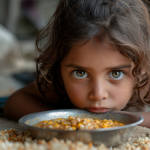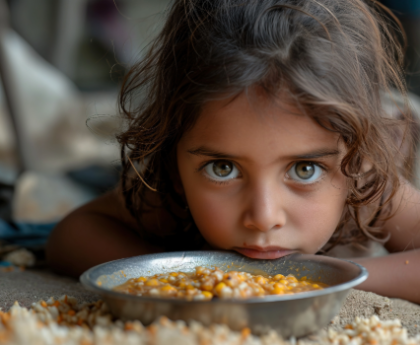
1. Centrality of Protection. All interventions undertaken in response to displacement in Ethiopia must be centered around protection. This means that all interventions – by all actors, across all clusters and sectors – must aim to reduce protection risks and violations faced by displaced populations. These risks and violations are identified in the annual humanitarian response plan. Accountability rests with the Humanitarian Country Team (HCT) but ensuring the Centrality of Protection in humanitarian action is the responsibility of all actors and clusters and is not the exclusive domain of the Protection Cluster.
Simplified message: Protection is central to all humanitarian efforts towards people in need, including those forced to flee. The Humanitarian Country Team (HCT), and all other actors and sectors, must work together to reduce protection risks for all those in need of humanitarian assistance. The annual humanitarian response plan outlines the main risks and violations. All Humanitarian actors, and not only the Protection Cluster, have a responsibility to ensure protection remains a central part of the joint humanitarian response.
2. Unhindered access and continuation of aid and service provision. Restricted access, particularly to conflictaffected areas, hinders the ability of humanitarian actors to implement lifesaving interventions, deliver lifesaving items, and provide services. For example, in northern Ethiopia including Amhara, conflict and limitations on electricity and communication services have restricted the delivery of lifesaving items and services to the civilian population. Access for humanitarian actors remains restricted in locations affected by violence (especially in Amhara, Oromia, parts of Benishangul Gumuz), while the safety and security of the civilian population, including IDPs, is deteriorating. Humanitarians urge those involved in conflict, clashes, and violence to end attacks against civilians, end human rights violations, and to facilitate the safe and unhindered access of humanitarian aid and actors to people in need. We request access to IDPs sites to support the authorities in delivering humanitarian services.
Simplified message: Humanitarian actors need unrestricted access to conflict-affected areas to deliver vital aid and services to those in need. Limitations on the use of electricity and communication services have contributed to restricting access to basic services and the delivery of life saving aid to the civilian populations. In several locations affected by violence (especially in Amhara, Oromia, parts of Benishangul Gumuz), civilians, including internally displaced persons, are at increased risk, especially of human rights violations. Humanitarian actors call for an end to all attacks against civilians, to cease human rights violations, and to facilitate safe and unhindered access to civilians.
Humanitarian actors also request access to IDPs sites to support authorities in delivering humanitarian services.
3. Scale up of Gender based Violence (GBV) Response and Risk mitigation with special attention to ending Child marriage. A combination of conflict, climate-related displacement, and the recent pause on food assistance exacerbated the risk of GBV, especially for women and girls. Women and girls have been exposed to physical violence, sexual harassment, child marriage, child labor, sale, and exchange for sex because of disrupted livelihoods, communal/overcrowded living conditions, family separation, and being the remaining breadwinner during the time of crisis. More specifically, Ethiopia ranks as the third highest among countries in Eastern and Southern Africa in terms of child marriage prevalence, being home to fifteen million child brides, of which six million were married before age 15. Increases in the rate of child marriage have been reported in drought- and conflict-affected locations, as families resort to this practice as a negative coping mechanism. Protection actors urge the authorities to continue their efforts to implement the National Costed Roadmap to End Child Marriage and FGM/C in Ethiopia 2020–2024 and ask donors and partners to support. Protection actors also demand an increase in protection and GBV services, especially in hard-toreach areas where such services are limited and not universally accessible, and a scale-up of a holistic GBV interventionsin areas newly affected by drought, flood, conflict, and violence. In the same line, all sectors are called upon to integrate GBV risk mitigation measures in service provision.
Simplified message: Immediately scale responses to all forms of GBV. Conflict, climate related displacement, and the recent pause on food assistance resulted in widespread GBV, especially against women and girls. They have been exposed to such risks because of lack of survival basics, overcrowded unsafe living conditions, family separation, and limited access to livelihoods, thus resorting to negative coping mechanisms including sale and exchange of sex for money or food, or sending their children to work. Humanitarian protection actors are calling for increased attention to this protection imperative, especially in hard-to-reach or newly climate affected areas.
Simplified message: End child marriage in Ethiopia. Home to fifteen million child brides, six million of whom were married before age 15, Ethiopia ranks among the top three of countries in Eastern and Southern Africa in terms of child marriage prevalence. Child marriage is exacerbated in drought- and conflict-affected areas, as families turn to it as a coping mechanism. Protection actors urge the authorities to continue the implementation of the National Costed Roadmap (2020-2024) to end child marriage and Female Genital Mutilation or cutting in Ethiopia, and to seek further support from donors and partners to do so.
4. Improve mental health and psychosocial support (MHPSS) services, and systematically include MHPSS aspects in assessment and programming. An increasing number of people are showing serious mental health issues and trauma related to directly experiencing or witnessing abuse, violence, gender-based violence loss of livelihood, family separation and displacement over the past months. MHPSS needs are often overlooked compared to other humanitarian responses. The Protection Cluster advocates for a strong inclusion of MHPSS in assessments and service delivery, prioritizing the communities most impacted by conflict, climate change and other violent and stressful situations.
5. Ensure a protective environment for children and scale up family reunification and family-based alternative care arrangements. Family separation is a primary child protection concern in regions affected by conflict or environmental hazard. A child separated from their caregiver can find themselves with other adults, alone or with other children, and increasingly exposed to violence, exploitation, discrimination, abuse, and neglect. Families are also reverting to negative coping mechanisms that involve children, such as child marriage, child labor, and street begging.
Child protection actors call for the implementation of all relevant measures to prevent and reduce family separation, increase the quality of and access to temporary family-based alternative care, and the scale-up of family reunification, adhering to international standards and the Alternative Childcare and Support Directive issued by the Ethiopia Ministry of Justice (Dir. No. 976/2023, 10 Oct. 2023).
Simplified message: It is imperative to ensure a protective environment for children, especially scaling up family reunification or alternative care arrangements. In conflict or drought affected regions, children are often separated from their parents or usual care givers and are exposed to many risks, including exploitation, discrimination, abuse, and neglect. Families are also recurring negative coping mechanisms for survival such as marrying their children at early ages or encouraging child labor and street begging. To mitigate these risks, Child Protection actors ask to put in place measures to prevent and reduce family separation, increase access to quality alternative care arrangements, and scale up family reunification.
6. Protection through documentation. Unable to replace identity documents left behind, lost, or confiscated while fleeing their homes, displaced populations cannot move freely outside of camps or within the country. The lack of identity or civil documentation hinders the ability to prove identity, family composition, and the exercise of other socio-economic rights such as the right to education and work, thus eclipsing the hope for self-reliance. Lack of documentation hinders the ability to open or access bank accounts, secure SIM cards, enroll children in school, as well as claim housing, land,and property in case of return to places of origin. The protection cluster advocates for the provision of identification documents to IDPs including vital events registrations.
Simplified message: Documents should be provided to Internally Displaced Persons (IDPs). Lack of valid documents severely limits their mobility, access to essential services, including education and health, livelihood opportunities and well as claiming of housing, land, and property in case of return to places of origin.
7. Advocacy for protection activity funding (protection activities are lifesaving). The needs of affected populations are increasing, but funding for protection activities remains inadequate. This prevents adequate assistance to vulnerable people and affected communities. The current level of protection risks, whether a result of conflict, ethnic violence or environmental hazard, amount to a protection crisis, with millions of people affected. Protection partners demand that the HCT and HC scale up advocacy for funding to ensure an adequate presence of protection partners and response, delivering essential lifesaving protection services for the people we serve.
Simplified message: Protection activities are lifesaving, yet inadequately resourced. With needs increasing and funding decreasing, additional resources are critical to mitigate risks faced by people.
The current level of protection risks, whether caused by conflict, ethnic violence, or climate, amounts to a protection crisis, with millions of people affected. However, funding for protection response in 2023 only covered less than half of the needs, leading to gaps and the inability to provide adequate aid to vulnerable persons and affected communities. The Humanitarian Country Team and the Humanitarian Coordinator must increase their advocacy to ensure that protection partners have sufficient funds to deliver lifesaving protection services.
8. Scale up multisectoral and integrated response in drought and conflict-affected affected areas. Insecurity and drought limit livelihood opportunities, and the destruction of livelihood infrastructure increases the competition for limited resources. Food security remains the most urgent humanitarian need across multiple regions, with devastating protection impacts. Protection actors welcome the recent resumption of food assistance for all populations across Ethiopia and call on authorities, humanitarian partners, the Humanitarian Country Team (HCT) and the Humanitarian Coordinator (HC) to scale up their response to mitigate the impact of the pause. Furthermore, the Protection Cluster calls for enhanced coordination between clusters, implementing partners, and authorities, to prevent risks related to flood and drought and plan for adequate, safe, and dignified support to people in affected areas.
Simplified message: Multisectoral and integrated response in drought and conflict-affected areas should be scaled up. Insecurity and drought have affected livelihood opportunities and, as a result, have led to increased competition over limited resources. Protection actors welcome the recent resumption of food assistance for all populations across Ethiopia and call on authorities, humanitarian partners, the Humanitarian Country Team (HCT) and the Humanitarian Coordinator (HC) to scale up their response to mitigate the impact of the pause. They also call for improved coordination between clusters, their implementing partners, and relevant authorities to prevent risks related to floods and droughts, and provide adequate, safe, and dignified support to people that are affected.
9. Ensure an inclusive humanitarian response. Meeting the needs of the most vulnerable is at the core of humanitarian programs. Vulnerable people – children, older people, people with disabilities, women – are at increased risk due to their potential lesser capacity to withstand the impacts of crises, the barriers and discrimination that limit their access to services, and the increased risk of exposure to harm, such as neglect, isolation, exploitation, and abuse.
The Protection Cluster calls on all actors to ensure an inclusive humanitarian response, in which assistance is provided based on need and without discrimination. This requires the meaningful participation, empowerment, capacitation, and association of women, older people, people with disabilities and other vulnerable groups at all stages of the response, along with collection of disaggregated data.
Simplified message: All assistance must be based on needs and provided without discrimination.
Humanitarian programs must prioritize meeting the needs of the most vulnerable, such as children, older people, persons with disabilities, and women. Vulnerable persons face heightened risks and discrimination, which limit their access to services and expose them to harm. To ensure an inclusive response, the Protection Cluster calls on all actors to provide assistance based on needs and without discrimination. This requires meaningful participation from vulnerable groups in all stages of the response, their empowerment and capacity-building. Disaggregated data needs to be collected to ensure the response adequately targets those most vulnerable.
10. Provide housing, land, and property (HLP) documentation, and solutions to HLP disputes. Security of tenure and housing, land and property rights is not granted for many displaced people who are willing to return to their areas of origin. Properties of displaced people have often been occupied, used, or damaged since their flight. While the humanitarian community registered many IDPs’ willingness to return home, it is foreseen that in the absence of ownership documentation, regaining houses, land, and property is a potential source of conflict. HLP actors urge relevant authorities to ensure security of tenure by providing the appropriate documentation when needed and identify housing and livelihood solutions for parties involved in HLP disputes.
Simplified message: Appropriate Housing, Land and Property (HLP) documents and solutions to disputes should be provided to internally displaced persons (IDPs). In many cases, the homes IDPs left behind have been occupied, used, or damaged by others which could lead to conflict. To ensure a safe and sustainable return, it is necessary to provide the appropriate documentation and protective housing and livelihood solutions. HLP actors urge relevant authorities to ensure security of tenure by providing the necessary documentation and resolving HLP disputes in a timely manner.
11. Strengthen mine action (MA) response, including collaboration with authorities for demining. The presence and fear of explosive ordnances (EO) hinders the return of displaced people to their areas of origin, farming, and access to livelihoods, meaning reduced durable solutionsfor IDPs, returnees and host communities. Protection actors urge the Government and regional state authorities to ensure more funding and increase the number of partners for mine action who can assess the presence of EO, collaborate to demine and clear affected locations, and increase education activities that reduce risk of EO-related incidents.
Simplified message: Demining should be prioritized to enable displaced persons to return home.
Protection actors urge the Government and Regional authorities to provide more funding for mine action to assess the presence of Explosive Ordnances (EO), collaborate to demine and clear affected locations, and raise awareness. This would enable internally displaced persons, returnees, and host communities to enjoy durable solutions.
12. Ensure safe and voluntary return and joint planning for durable solutions. The ongoing violence and clashes in various regions (Northern Ethiopia, Oromia, Somali, and Gambella regions, among others) have contributed to the feeling of insecurity and have triggered further displacement waves. For many IDPs, the feeling of not being able to settle in a new location or return to their area of origin impedes durable solutions and integration into the social structure of their host or their own community. Humanitarian and protection actors invite the relevant authorities to increase collaboration to ensure safe and voluntary movements for all IDPs willing to return to their areas of origin; and to plan jointly for IDPs’ access to safe and dignified living conditions and livelihood opportunities.
Simplified message: Durable solutions, including the safe and voluntary returns of displaced persons should be supported. The ongoing violence in various regions of Ethiopia (Northern Ethiopia, Oromia, Somali, Gambella) has increased feelings of insecurity among the population, leading to further displacement. Many internally displaced persons feel like they cannot settle in their new locations/communities or return home. Humanitarian and Protection actors are calling on authoritiesto increase collaboration to support safe and voluntary returns for all IDPs willing to go home, provide assistance for dignified living conditions and facilitate access to livelihood opportunities.
13. Support advocacy for setting up of Justice systems in areas that have been agreed upon as safe to return.
In areas where return has been declared safe jointly with government and humanitarian actors, protection actors are urged to support a minimum set up of relevant structures to ensure access to justice. This will among others, support claims associated with HLP where documentation could have been misplaced, destroyed, or where family members who owned the property deceased during conflict or displacement.
This post was originally published on 3rd party site mentioned in the title of this page




